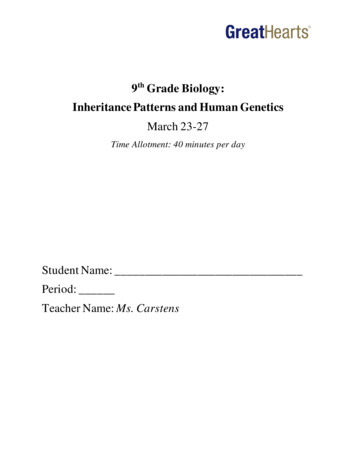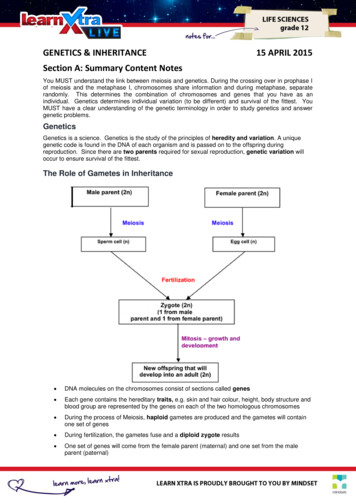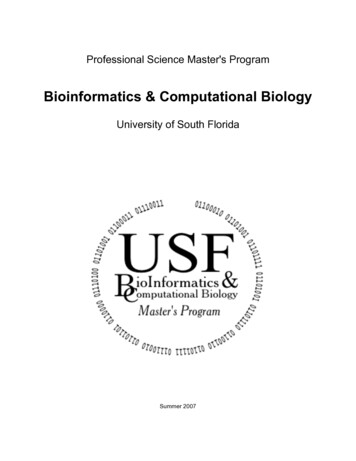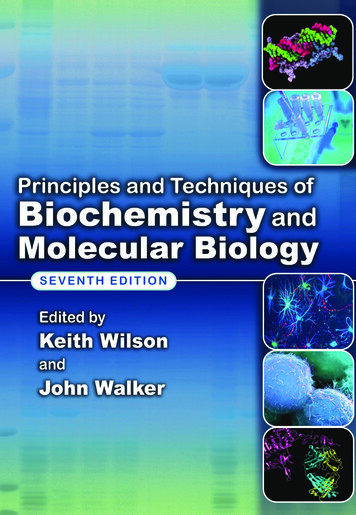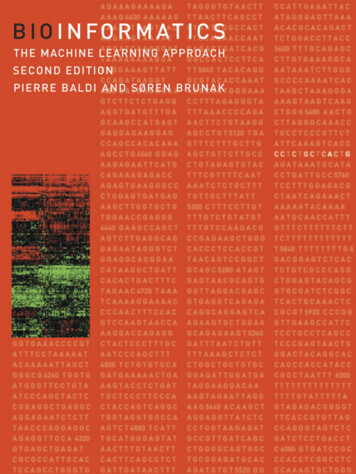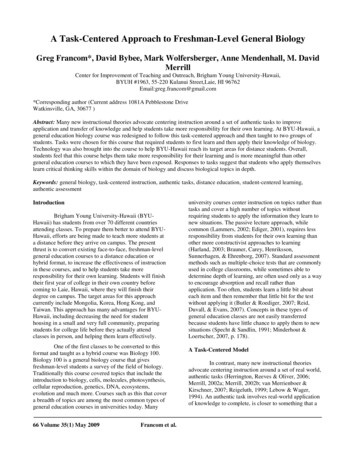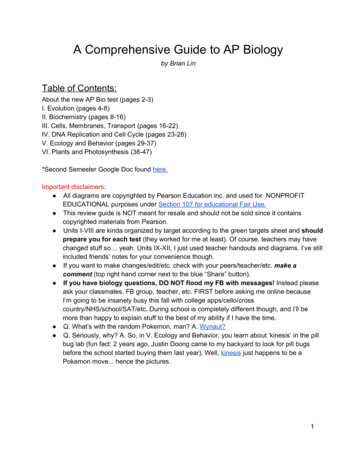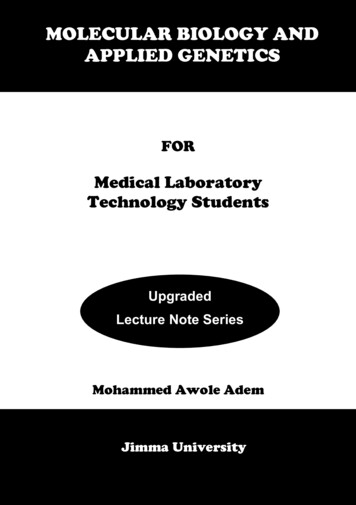
Transcription
MOLECULAR BIOLOGY ANDAPPLIED GENETICSFORMedical LaboratoryTechnology StudentsUpgradedLecture Note SeriesMohammed Awole AdemJimma University
MOLECULAR BIOLOGY ANDAPPLIED GENETICSForMedical LaboratoryTechnician StudentsLecture Note SeriesMohammed Awole AdemUpgraded - 2006In collaboration withThe Carter Center (EPHTI) and The FederalDemocratic Republic of Ethiopia Ministry ofEducation and Ministry of HealthJimma University
PREFACEThe problem faced today in the learning and teaching ofApplied Genetics and Molecular Biology for ealthinstitutions primarily from the unavailability of textbooksthat focus on the needs of Ethiopian students.This lecture note has been prepared with the primaryaim of alleviating the problems encountered in theteaching of Medical Applied Genetics and prevailing among the different teaching and traininghealth institutions. It can also be used in teaching anyintroductory course on medical Applied Genetics andMolecular Biology and as a reference material.This lecture note is specifically designed for medicallaboratory technologists, and includes only those areasof molecular cell biology and Applied Genetics relevantto degree-level understanding of modern laboratorytechnology. Since genetics is prerequisite course tomolecular biology, the lecture note starts with Geneticsi
followed by Molecular Biology. It provides students withmolecular background to enable them to understandand critically analyze recent advances in laboratorysciences.Finally, it contains a glossary, which summarizesimportant terminologies used in the text. Each chapterbegins by specific learning objectives and at the end ofeach chapter review questions are also included.We welcoming the reviewers and users input regardingthis edition so that future editions will be better.ii
ACKNOWLEDGEMENTSI would like to acknowledge The Carter Center for itsinitiative, financial, material and logistic supports for thepreparation of this teaching material. We are indebted toThe Jimma University that support directly or indirectlyfor the visibility of this lecture note preparation.I extend our appreciation to the reviewers of neh Kelemu , Biochemistry Department, Schoolof Medicine, and Ato Yared Alemu, School of MedicalLaboratory Technology, Jimma University.We dication.I also acknowledge all reviewers of the manuscriptduring inter-institutional workshop and those whoparticipated as national reviewers.Last but not least I would like to acknowledge tyhosewho helped me directly or indirectly.iii
TABLE OF CONTENTSPreface.iAcknowledgement.iiiTable of Contents.ivList of Figures .xiGeneral objectives .xivCHAPTER ONE: THE CELL1.0. Eukaryotic and Prokaryotic Cell .11.1. Function of the cell .51.2. The chemical components of Cell membranes .81.3. Membrane structure.10CHAPTER TWO: THE CELL CYCLE2.0. Introduction .132.1. Control of the Cell Cycle .152.2. Steps in the cycle.162.3. Meiosis and the Cell Cycle.182.4. Quality Control of the Cell Cycle .182.5. Regulation of the Cell Cycle.19iv
2.6. Mitosis.232.7. Meiosis.302.8. Comparison of Meiosis and Mitosis .332.9. Meiotic errors .332.10. Mitosis, Meiosis, and Ploidy.342.11. Meiosis and Genetic Recombination.352.12. Meiosis and Sexual Reproduction.38CHAPTER THREE: MACROMOLECULES3.0. Introduction .403.1. Carbohydrate .413.2. Nucleic acids .433.3. Protein .463.4. Helix.493.5. Tertiary structure.583.6. Macromolecular Interactions.633.7. Denaturation .643.8. Renaturation .69CHAPTER FOUR: GENETICS4.1. Mendelian genetics .734.2. Mendel's first law: principle of segregation .794.3. Mendel's second law: principle of independent assortment .804.4. Mendel's third law: principle of Dominance.81v
4.5. Exception to Mendelian Genetics .82CHAPTER FIVE: CHROMOSOME STRUCTURE AND FUNCTION5.1. Chromosome Morphology.965.2. Normal Chromosome.975.3. Chromosome Abnormalities.1005.4. Types of Chromatin .1055.5. Codominant alleles .1065.6. Incomplete dominance.1075.7. Multiple alleles .1085.8. Epistasis.1085.9. Environment and Gene Expression .1095.10. Polygenic Inheritance .1105.11. Pleiotropy .1125.12. Human Chromosome Abnormalities .1135.13. Cytogenetics .119CHAPTER SIX: LINKAGE6.0. Introduction .1256.1. Mapping .1286.2. Double Crossovers .1326.3. Interference.1326.4. Deriving Linkage Distance and Gene Order fromThree-Point Crosses .vi134
CHAPTER SEVEN: PEDIGREE ANALYSIS7.1. Symbols Used to Draw Pedigrees .1457.2. Modes of inheritance.1477.3. Autosomal dominant .1507.4. Autosomal recessive.1517.5. Mitochondrial inheritance .1577.6. Uniparental disomy .158CHAPTER EIGHT: NUCLEIC ACID STRUCTURE AND FUNCTION8.0. Introduction .1618.1. Deoxyribonucleic acid .1628.2. Ribonucleic acid.1678.3. Chemical differences between DNA & RNA .1708.4. DNA Replication.1738.5. Control of Replication.1918.6. DNA Ligation.193CHAPTER NINE:DNA DAMAGE AND REPAIR9.0. Introduction .2009.1. Agents that Damage DNA .2019.2. Types of DNA damage.2029.3. Repairing Damaged Bases .2039.4. Repairing Strand Breaks.209vii
9.5. Mutation .2109.6. Insertions and Deletions .2149. 7. Duplications .2169.8. Translocations.2199.9. Frequency of Mutations .2209.10.Measuring Mutation Rate.223CHAPTER TEN: GENE TRANSFER IN BACTERIA10.0. Introduction .22610.1. Conjugation.22710.2. Transduction .23210.3. Transformation.23810.4. Transposition .24110.5. Recombination .24210.6. Plasmid .243CHAPTER ELEVEN: TRANSCRIPTION AND TRANSLATION11.0. Introduction .24711.1. Transcription .24911.2. Translation .25211.3. Triplet Code .25411.4. Transfer RNA .25811.5. Function of Ribosome .26111.5. The Central Dogma.261viii
11.7. Protein Synthesis .264CHAPTER TWELVE: CONTROL OF GENE EXPRESSION12.0. Introduction .26812.1. Gene Control in Prokaryotes.27212.2. The lac Operon .27512.2. The trp Operon.28112.3. Gene Control in Eukaryotes.28512.4. Control of Eukaryotic Transcription Initiation.29112.5. Transcription and Processing of mRNA .296CHAPTER THIRTEEN: RECOMBINANT DNA TECHNOLOGY13.0. Introduction .30313.1. Uses of Genetic Engineering .30413.2. Basic Tools of Genetic Engineering .30513.3. Enzymes in Molecular Biology .30613.4. DNA manipulation .31413.5. Making a Recombinant DNA: An Overview .31713.6. Cloning.31813.7. Cloning DNA .33313.8. Cloning into a Plasmid .33913.9. Expression and Engineering of Macromolecules34313.10. Creating mutations.347ix
CHAPTER FOURTEEN: DNA SEQUENCING14.0. Introduction .35514.1. Sanger Method for DNA Sequencing.36114.2. An Automated sequencing gel .37114.3. Shotgun Sequencing.376CHAPTER FIFTEEN: MOLECULAR TECHNIQUES15. 1. Electrophoresis .38015.2. Complementarity and Hybridization .38615.3. Blots.38915.4. Polymerase Chain Reaction .40415.5. RFLP.42315.6. DNA Finger printing .431Glossary .439x
List of FiguresFig.1. Prokaryotic Cell.2Fig. 2: Eukaryotic Cell.2Fig. 3. The cell cycle .14Fig. 4: Overview of Major events in Mitosis .23Fig 5: Prophase.26Fig. 6: Prometaphase.27Fig. 7: Metaphase .27Fig 8: Early anaphase .28Fig. 9: Telophase .29Fig. 10: Overview of steps in meiosis .32Fig 11: Cross pollination and self pollination and their respectivegeneration .76Fig. 12: Self pollination of f2 generation.77Fig.13. Genetic composition of parent generation with their f1and f2Generation .xi78
Fig.14. Segregation of alleles in the production of sex cells .79Fig. 15. A typical pedigree .151Fig.1 6. a) A 'typical' autosomal recessive pedigree, andb) an autosomal pedigree with inbreeding .152Fig.17. Maternal and paternal alleles and their breeding.154Fig. 18. Comparison of Ribose and Deoxyribose sugars.164Fig.19. DNA Replication .174Fig.21. Effects of mutation .212Fig.22. Frame shift .214Fig.23 Genome Duplication .217Fig 24 Gene Transfer during conjugation .331Fig. 25 Transcription and translation.247Fig.26. Transcription .250Fig.27. Steps in breaking the genetic code: the deciphering of apoly-U mRNA .254Fig.28. The genetic code .256Fig.29. Transfer RNA.259xii
Fig.30.The central dogma. .263Fig. 31.A polysome .266Fig. 32.Regulation of the lac operon in E. coli .279Fig.33 Typical structure of a eukaryotic mRNA gene.294Fig.34. Transforming E.coli .322Fig.35. Dideoxy method of sequencing.363Fig.36. The structure of a dideoxynucleotide .368xiii
INTRODUCTIONMolecular genetics, or molecular biology, is the study ofthe biochemical mechanisms of inheritance. It is thestudy of the biochemical nature of the genetic materialand its control of phenotype. It is the study of theconnection between genotype and phenotype. Theconnection is a chemical one.Control of phenotype is one of the two roles of DNA(transcription). You have already been exposed to theconcept of the Central Dogma of Molecular Biology, i.e.that the connection between genotype and phenotype isDNA (genotype) to RNA to enzyme to cell chemistry tophenotype.James Watson and Francis Crick received the 1953Nobel Prize for their discovery of the structure of theDNA molecule. This is the second most importantdiscovery in the history of biology, ranking just behindthat of Charles Darwin. This discovery marked thebeginning of an intense study of molecular biology, onethat dominates modern biology and that will continue todo so into the foreseeable future. .xiv
The essential characteristic of Molecular Genetics is thatgene products are studied through the genes thatencode them.This contrasts with a biochemicalapproach, in which the gene products themselves arepurified and their activities studied in vitro.Genetics tells that a gene product has a role in theprocess that are studying in vivo, but it doesn’tnecessarily tell how direct that role is. Biochemistry, bycontrast, tells what a factor can do in vitro, but it doesn’tnecessarily mean that it does it in vivo.The genetic and biochemical approaches tell youdifferent things:GeneticsBiochemistryÆ has a role, but not how directÆtells what a protein can do invitro, but not whether it reallydoes it in vivoThese approaches therefore tell different things. Bothare needed and are equally valuable. When one cancombine these approaches to figure out what axv
gene/protein does, the resulting conclusions are muchstronger than if one only use one of these strategies.DEVELOPMENTOFGENETICSANDMOLECULAR BIOLOGY1866- Genetics start to get attention when MendelExperimented with green peas and publish hisfinding1910- Morgan revealed that the units of heredity arecontained with chromosome,1944- It is confirmed through studies on the bacteria thatit was DNA that carried the genetic whichstudyDNAsubsequentlybyX-rayleadtounrevealing the double helical structure of DNA byWatson and Crick1960s- Smith demonstrate that the DNA can be cleavedby restriction enzymesxvi
1966 -Gene transcription become reality1975- Southern blot was invented1977- DNA sequencing methodology discovered1981-Genetic diagnosis of sickle cell disease was firstshown to be feasible by kan and Chang1985- PCR develop by Mullis an Co-workers2001-Draft of Human genome sequence was revealedxvii
Molecular Biology and Applied GeneticsCHAPTER ONETHE CELLSpecific learning objectives Identify an eukaryotic and prokaryotic cell Describe chemical composition of the cellmembrane List the structure found in a membrane Describe the role of each component found incell membrane1.0. Eukaryotic and Prokaryotic Cell Cells in our world come in two basic types,prokaryotic and eukaryotic. "Karyose" comes from aGreek word which means "kernel," as in a kernel ofgrain. In biology, one use this word root to refer tothe nucleus of a cell. "Pro" means "before," and "eu"means "true," or "good." So "Prokaryotic" means "before a nucleus," and"eukaryotic" means "possessing a true nucleus."1
Molecular Biology and Applied Genetics Prokaryotic cells have no nuclei, while eukaryoticcells do have true nuclei. This is far from the onlydifference between these two cell types, however.Here's a simple visual comparison between aprokaryotic cell and eukaryotic cell:Fig. 1. Prokaryotic cell This particular eukaryotic cell happens to be ananimal cell, but the cells of plants, fungi and protistsare also eukaryotic.Fig. 2. Eukaryotic cell2
Molecular Biology and Applied Genetics Despite their apparent differences, these two celltypes have a lot in common. They perform most ofthe same kinds of functions, and in the same ways.These include: Both are enclosed by plasma membranes, filledwith cytoplasm, and loaded with small structurescalled ribosomes. Both have DNA which carries the archivedinstructions for operating the cell. And the similarities go far beyond the visible-physiologically they are very similar in manyways. For example, the DNA in the two cell typesis precisely the same kind of DNA, and thegenetic code for a prokaryotic cell is exactly thesame genetic code used in eukaryotic cells. Some things which seem to be differences aren't.For example, the prokaryotic cell has a cell wall, andthis animal cell does not. However, many kinds ofeukaryotic cells do have cell walls. Despite all of these similarities, the differences arealso clear. It's pretty obvious from these two littlepictures that there are two general categories ofdifference between these two cell types: size and3
Molecular Biology and Applied Geneticscomplexity. Eukaryotic cells are much larger andmuch more complex than prokaryotic cells. Thesetwo observations are not unrelated to each other.If we take a closer look at the comparison of these cells,we see the following differences:1. Eukaryotic cells have a true nucleus, bound by adoublemembrane.Prokaryoticcellshavenonucleus.2. Eukaryotic DNA is complexed with proteins called"histones," and is organized into chromosomes;prokaryotic DNA is "naked," meaning that it has nohistones associated with it, and it is not formed intochromosomes. A eukaryotic cell contains a numberof chromosomes; a prokaryotic cell contains onlyone circular DNA molecule and a varied assortmentof much smaller circlets of DNA called "plasmids."The smaller, simpler prokaryotic cell requires farfewer genes to operate than the eukaryotic cell.3. Both cell types have many, many ribosomes, but theribosomes of the eukaryotic cells are larger andmore complex than those of the prokaryotic cell. Aeukaryotic ribosome is composed of five kinds of4
Molecular Biology and Applied GeneticsrRNA and about eighty kinds of proteins. Prokaryoticribosomes are composed of only three kinds ofrRNA and about fifty kinds of protein.4. The cytoplasm of eukaryotic cells is filled with alarge, complex collection of organelles, many ofthem enclosed in their own membranes; es which are independent of the plasmamembrane.5. One structure not shown in our prokaryotic cell iscalled a mesosome. Not all prokaryotic cells havethese. The mesosome is an elaboration of theplasma membrane--a sort of rosette of ruffledmembrane intruding into the cell.1.1. Function of the cell Cell serves as the structural building block to formtissues and organ Each cell is functionally independent- it can live onits own under the right conditions:5
Molecular Biology and Applied Genetics it can define its boundaries and protect itselffrom externalchanges causing internalchanges it can use sugars to derive energy fordifferent processes which keep it alive it contains all the information required forreplicating itself and interacting with othercellsin order to produce a multicellularorganisms It is even possible to reproduce the entireplant from almost any single cell of the plant Cell wall protects and supports cell made from carbohydrates- cellulose andpectin- polysaccharides strong but leaky- lets water and chemicalspass through-analogous to a cardboard box Cell membrane membrane is made up from lipids - made fromfatty acids water-repelling nature of fatty acidsmakes the diglycerides form a6
Molecular Biology and Applied Genetics sheet or film which keeps water from movingpast sheet (think of a film of oil on water) membrane is analogous to a balloon- thespherical sheet wraps around the cell andprevents water from the outside from mixingwith water on the inside membrane is not strong, but is water-tight- letsthings happen inside the cell that are differentthan what is happening outside the cell and sodefines its boundaries. Certain gatekeepingproteins in the cell membrane will let things inand out. Cytosol - watery inside of cell composed of salts,proteins which act as enzyme Microtubules and microfilaments - cables made outof protein which stretch around the cell provide structure to the cell, like cables andposts on a suspension bridge provide a structure for moving cell componentsaround the cell -sort of like a moving conveyerbelt.7
Molecular Biology and Applied Genetics Organelles - sub-compartments within the cell ounded by a membrane that makes it includeribosome,nucleus,endoplasmicreticulum, and golgi apparatus. (Refer any biologytext book for detail)1.2. The chemical components of cellmembranesThe components cell membrane includes: Lipid--cholesterol,phospholipidandsphingolipid Proteins Carbohydrate -- as glycoproteinDifferences in composition among membranes (e.g.myelin vs. inner mitochondrial membrane) Illustrate the variability of membrane structure. This is due to the differences in function.Example: Mitochondrial inner membrane has8
Molecular Biology and Applied Geneticshigh amounts of functional electron transportsystem proteins. Plasma membrane, with fewer functions (mainly iontransport), has less protein. Membranes with similar function (i.e. from thesame organelle) are similar across specieslines, but membranes with different function(i.e. from different organelles) may differstrikingly within a species. Carbohydrates of membranes are present attachedto protein or lipid as glycoprotein or glycolipid.1. Typical sugars in glycoproteins and glycolipidsinclude glucose, galactose, mannose, ine, N-acetylgalactosamine andN-acetylneuraminic acid (sialic acid).2. Membrane sugars seem to be involved inidentification and recognition.9
Molecular Biology and Applied Genetics1.3. Membrane structureThe amphipathic properties of the phosphoglyceridesand sphingolipids are due to their structures.1. The hydrophilic head bears electric chargescontributed by the phosphate and by some of thebases. These charges are responsible for thehydrophilicity. Note that no lipid bears a positive charge.They are all negative or neutral. Thusmembranes are negatively charged.2. The long hydrocarbon chains of the acyl groupsare hydrophobic, and tend to exclude water.3. Phospholipidsinanaqueousmediumspontaneously aggregate into orderly arrays. Micelles:orderlyarraysofmoleculardimensions. Note the hydrophilic headsoriented outward, and the hydrophobic acylgroupsorientedinward.Micellesareimportant in lipid digestion; in the intestinethey assist the body in assimilating lipids.10
Molecular Biology and Applied Genetics Lipid bilayers can also form. Liposomes are structures related to micelles,but they are bilayers, with an internalcompartment. Thus there are three regionsassociated with liposomes: -The exterior, themembrane itself and the inside. Liposomessubstancescanbe madedissolvedinwithspecifictheinteriorcompartment. These may serve as modes ofdelivery of these substances.4. The properties of phospholipids determine thekinds of movement they can undergo in a bilayer. Modes of movement that maintain thehydrophilic head in contact with the aqueoussurroundings and the acyl groups in theinterior are permitted. Transverse movement from side to side ofthe bilayer (flip-flop) is relatively slow, and isnot considered to occur significantly.11
Molecular Biology and Applied GeneticsReview Questions1. Compare and contrast eukaryotic and prokaryoticcell.2. Whatarethechemicalcompositionsofcellmembrane?3. Which chemical composition is found in highproportion?4. What are the roles of membrane proteins?5. What are the functions of a cell?12
Molecular Biology and Applied GeneticsCHAPTER TWOTHE CELL CYCLESpecific learning objectivesAt the end of this Chapter students are expected to Describe the components of cell cycle List steps of cell cycle Outline the steps of mitosis and meiosis Distinguish the difference between mitosis andmeiosis2.0. IntroductionoA eukaryotic cell cannot divide into two, the two intofour, etc. unless two processes alternate: doubling of its genome (DNA) in S phase(synthesis phase) of the cell cycle; halving of that genome during mitosis (Mphase).o The period between M and S is called G1; thatbetween S and M is G2.13
Molecular Biology and Applied GeneticsFig. 3. The Cell Cycle14
Molecular Biology and Applied Genetics So, the cell cycle consists of: G1 growthandpreparationofthechromosomes for replication S synthesis of DNA (and centrosomes) M mitosiso When a cell is in any phase of the cell cycle otherthan mitosis, it is often said to be in interphase.2.1. Control of the Cell Cycle The passage of a cell through the cell cycle iscontrolled by proteins in the cytoplasm. Among themain players in animal cells are: Cyclinsoa G1 cyclin (cyclin D)oS-phase cyclins (cyclins E and A)omitotic cyclins (cyclins B and A)Their levels in the cell rise and fall with thestages of the cell cycle. Cyclin-dependent kinases (Cdks)15
Molecular Biology and Applied Geneticsoa G1 Cdk (Cdk4)oan S-phase Cdk ((Cdk2)oan M-phase Cdk (Cdk1)Their levels in the cell remain fairly stable, but eachmust bind the appropriate cyclin (whose levels fluctuate)in order to be activated. They add phosphate groups toa variety of protein substrates that control processes inthe cell cycle. The anaphase-promoting complex (APC). (TheAPC is also called the cyclosome, and thecomplex is ofen designated as the APC/C.) TheAPC/Cotriggers the events leading to destructionof the cohesins thus allowing the sisterchromatids to separate;odegrades the mitotic cyclin B.2.2. Steps in the cycle A rising level of G1-cyclins bind to their Cdks andsignal the cell to prepare the chromosomes forreplication.16
Molecular Biology and Applied Genetics A rising level of S-phase promoting factor (SPF) —which includes cyclin A bound to Cdk2 — enters thenucleus and prepares the cell to duplicate its DNA(and its centrosomes). As DNA replication continues, cyclin E is destroyed,and the level of mitotic cyclins begins to rise (in G2). M-phase promoting factor (the complex of mitoticcyclins with the M-phase Cdk) initiatesoassembly of the mitotic spindleobreakdown of the nuclear envelopeocondensation of the chromosomes These events take the cell to metaphase of mitosis. At this point, the M-phase promoting factor activatesthe anaphase-promoting
Molecular Biology and as a reference material. This lecture note is specifically designed for medical laboratory technologists, and includes only those areas of molecular cell biology and Applied Genetics relevant to degree-level understanding of modern labora
